First Report of Small Skeletal Fossils from the Upper Guojiaba Formation (Series 2, Cambrian), Southern Shaanxi, South China
Abstract
Simple Summary
Abstract
1. Introduction
2. Geological Background
3. Materials and Methods
4. Small Skeletal Fossils and Elemental Analysis of the Guojiaba Formation
5. Systematic Paleontology
6. Regional Fossil Occurrences and Stratigraphic Correlations of the Guojiaba Formation
7. Conclusions
Author Contributions
Funding
Institutional Review Board Statement
Informed Consent Statement
Data Availability Statement
Acknowledgments
Conflicts of Interest
References
- Skovsted, C.; Knight, I.; Balthasar, U.; Boyce, D. Depth Related Brachiopod Faunas from the Lower Cambrian Forteau Formation of Southern Labrador and Western Newfoundland, Canada. Palaeontol. Electron. 2017, 38, 148–153. [Google Scholar] [CrossRef] [PubMed]
- Topper, T.; Betts, M.J.; Dorjnamjaa, D.; Li, G.; Li, L.; Altanshagai, G.; Enkhbaatar, B.; Skovsted, C.B. Locating the BACE of the Cambrian: Bayan Gol in Southwestern Mongolia and Global Correlation of the Ediacaran–Cambrian Boundary. Earth-Sci. Rev. 2022, 229, 104017. [Google Scholar] [CrossRef]
- Pyle, L.J.; Narbonne, G.M.; Nowlan, G.S.; Xiao, S.; James, N.P. Early Cambrian metazoan eggs, embryos, and phosphatic microfossils from northwestern Canada. J. Paleontol. 2006, 80, 811–825. [Google Scholar] [CrossRef]
- Jell, P.A. Earliest known pelecypod on Earth—A new Early Cambrian genus from South Australia. Alcheringa 1980, 4, 233–239. [Google Scholar] [CrossRef]
- Kouchinsky, A.; Bengtson, S.; Clausen, S.; Vendrasco, M.J. An early Cambrian fauna of skeletal fossils from the Emyaksin Formation, northern Siberia. Acta Palaeontol. Pol. 2013, 60, 421–512. [Google Scholar] [CrossRef]
- Guo, J.F.; Li, Y.; Li, G.X. Small Shelly Fossils from the Early Cambrian Yanjiahe Formation, Yichang, Hubei, China. Gondwana Res. 2014, 25, 999–1007. [Google Scholar] [CrossRef]
- Zhang, Z.F.; Zhang, Z.L.; Li, G.X.; Holmer, L.E. The Cambrian brachiopod fauna from the first-trilobite age Shuijingtuo Formation in the Three Gorges area of China. Palaeoworld 2016, 25, 333–355. [Google Scholar] [CrossRef]
- Zhang, Z.L.; Zhang, Z.F.; Holmer, L.E.; Chen, F.Y. Post-metamorphic allometry in the earliest acrotretoid brachiopods from the lower Cambrian (Series 2) of South China, and its implications. Palaeontology 2018, 61, 183–207. [Google Scholar] [CrossRef]
- Zhang, Z.L.; Pour, M.G.; Popov, L.E.; Holmer, L.E.; Chen, F.Y.; Chen, Y.L.; Zhang, Z.F. The oldest Cambrian trilobite-brachiopod association in South China. Gondwana Res. 2021, 89, 147–167. [Google Scholar] [CrossRef]
- Zhang, Z.L.; Zhang, Z.F.; Ma, J.Y.; Taylor, P.D.; Strotz, L.C.; Jacquet, S.M.; Brock, G.A. Fossil evidence unveils an early Cambrian origin for Bryozoa. Nature 2021, 599, 251–255. [Google Scholar] [CrossRef]
- Zhang, Z.F.; Holmer, L.E.; Liang, Y.; Chen, Y.L.; Duan, X.L. The oldest ‘Lingulellotreta’ (Lingulata, Brachiopoda) from China and its phylogenetic significance: Integrating new material from the Cambrian Stage 3–4 Lagerstätten in eastern Yunnan, South China. J. Syst. Palaeontol. 2020, 18, 945–973. [Google Scholar] [CrossRef]
- Zhang, Z.L.; Zhang, Z.F.; Holmer, L.E. Studies on the shell ultrastructure and ontogeny of the oldest acrotretid brachiopods from South China. Acta Palaeontol. Sin. 2017, 54, 483–503. [Google Scholar] [CrossRef]
- Zhang, Z.L.; Holmer, L.E.; Chen, F.Y.; Brock, G.A. Ontogeny and evolutionary significance of a new acrotretide brachiopod genus from Cambrian Series 2 of South China. J. Syst. Palaeontol. 2020, 18, 1569–1588. [Google Scholar] [CrossRef]
- Li, L.Y.; Zhang, X.L.; Skovsted, C.B.; Yun, H.; Pan, B.; Li, G.X. Homologous shell microstructures in Cambrian hyoliths and molluscs. Palaeontology 2019, 62, 515–532. [Google Scholar] [CrossRef]
- Yun, H.; Zhang, X.L.; Li, L.Y.; Pan, B.; Li, G.X.; Brock, G.A. Chancelloriid sclerites from the lowermost Cambrian of North China and discussion of sclerite taxonomy. Geobios 2019, 53, 65–75. [Google Scholar] [CrossRef]
- Liu, F.; Skovsted, C.B.; Topper, T.P.; Zhang, Z.F.; Shu, D.G. Are hyoliths Palaeozoic lophophorates? Natl. Sci. Rev. 2020, 7, 453–469. [Google Scholar] [CrossRef]
- Bengtson, S.; Conway Morris, S.; Cooper, B.J.; Jell, P.A.; Runnegar, B.N. Early Cambrian Fossils from South Australia; Association of Australasian Palaeontologists: Brisbane, Australia, 1990. [Google Scholar]
- Qian, Y.; Chen, M.E.; He, T.G.; Zhu, M.Y.; Yin, G.Z.; Feng, W.M.; Xu, J.T.; Jiang, Z.W.; Liu, D.Y.; Li, G.X.; et al. Taxonomy and Biostratigraphy of Small Shelly Fossils in China; Science Press: Beijing, China, 1999; pp. 1–247. (In Chinese) [Google Scholar]
- Steiner, M.; Li, G.X.; Qian, Y.; Zhu, M.Y.; Erdtmann, B.D. Neoproterozoic to early Cambrian small shelly fossil assemblages and a revised biostratigraphic correlation of the Yangtze Platform (China). Palaeogeogr. Palaeoclimatol. Palaeoecol. 2007, 254, 67–99. [Google Scholar] [CrossRef]
- Dzik, J. Evolution of small shelly fossils’ assemblages of the Early Paleozoic. Acta Palaeontol. Pol. 1994, 39, 247–313. [Google Scholar]
- Elicki, O. The utility of late Early to Middle Cambrian small shelly fossils from the western Mediterranean. Geosci. J. 2005, 9, 161. [Google Scholar] [CrossRef]
- Yang, B.; Steiner, M.; Keupp, H. Early Cambrian palaeobiogeography of the Zhenba–Fangxian Block (South China): Independent terrane or part of the Yangtze Platform? Gondwana Res. 2015, 28, 1543–1565. [Google Scholar] [CrossRef]
- Hearing, T.W.; Harvey, T.H.; Williams, M.; Leng, M.J.; Lamb, A.L.; Wilby, P.R.; Donnadieu, Y. An early Cambrian greenhouse climate. Sci. Adv. 2018, 4, eaar5690. [Google Scholar] [CrossRef]
- Li, G.X.; Holmer, L.E. Early Cambrian lingulate brachiopods from the Shaanxi Province, China. GFF 2004, 126, 193–211. [Google Scholar] [CrossRef]
- Li, G.X.; Zhu, M.Y.; Van Iten, H.; Li, C.W. Occurrence of the earliest known Sphenothallus Hall in the Lower Cambrian of southern Shaanxi Province, China. Geobios 2004, 37, 229–237. [Google Scholar] [CrossRef]
- Steiner, M.; Zhu, M.Y.; Weber, B.; Geyer, G. The Lower Cambrian of eastern Yunnan: Trilobite-based biostratigraphy and related faunas. Acta Palaeontol. Sin. 2001, 40, 63–79. [Google Scholar]
- Steiner, M.; Li, G.X.; Qian, Y.; Zhu, M.Y. Lower Cambrian small shelly fossils of northern Sichuan and southern Shaanxi (China), and their biostratigraphic importance. Geobios 2004, 37, 259–275. [Google Scholar] [CrossRef]
- Yuan, K.X.; Zhu, M.Y.; Zhang, J.M.; Van Iten, H. Biostratigraphy of archaeocyathan horizons in the Lower Cambrian Fucheng section, South Shaanxi Province: Implications for regional correlations and archaeocyathan evolution. Acta Palaeontol. Sin. 2001, 40, 115–129. [Google Scholar]
- Huo, S.C.; Cui, Z.L.; Wang, X.L.; Zhang, Y.Z. The geological succession and geographical distribution of Cambrian Bradoriida from China. J. Southeast Asian Earth Sci. 1989, 3, 107–118. [Google Scholar] [CrossRef]
- Shu, D.G.; Vannier, J.; Luo, H.L.; Chen, L.; Zhang, X.L.; Hu, S.X. Anatomy and lifestyle of Kunmingella (Arthropoda, Bradoriida) from the Chengjiang fossil Lagerstätte (lower Cambrian; southwest China). Lethaia 1999, 32, 279–298. [Google Scholar] [CrossRef]
- Devaere, L.; Clausen, S.; Sosa-Leon, J.P.; Palafox-Reyes, J.J.; Buitron-Sanchez, B.E.; Vachard, D. Early Cambrian small shelly fossils from northwest Mexico: Biostratigraphic implications for Laurentia. Palaeontol. Electron. 2019, 22, 1–50. [Google Scholar] [CrossRef]
- Betts, M.J.; Paterson, J.R.; Jago, J.B.; Jacquet, S.M.; Skovsted, C.B.; Topper, T.P.; Brock, G.A. A new lower Cambrian shelly fossil biostratigraphy for South Australia. Gondwana Res. 2016, 36, 176–208. [Google Scholar] [CrossRef]
- Xie, Y.S. Small shelly fossils in Qiongzhusi Stage of Lower Cambrian in Zhenba County Shaanxi Province. J. Chengdu Coll. Geol. 1988, 15, 21–29. [Google Scholar]
- Yun, H.; Zhang, X.L.; Li, L.Y.; Zhang, M.Q.; Liu, W. Skeletal fossils and microfacies analysis of the lowermost Cambrian in the southwestern margin of the North China Platform. J. Asian Earth Sci. 2016, 129, 54–66. [Google Scholar] [CrossRef]
- Pan, B.; Skovsted, C.B.; Brock, G.A.; Topper, T.P.; Holmer, L.E.; Li, L.Y.; Li, G.X. Early Cambrian organophosphatic brachiopods from the Xinji Formation, at Shuiyu section, Shanxi Province, North China. Palaeoworld 2020, 29, 512–533. [Google Scholar] [CrossRef]
- Hu, Y.Z.; Holmer, L.E.; Liang, Y.; Duan, X.L.; Zhang, Z.F. First Report of Small Shelly Fossils from the Cambrian Miaolingian Limestones (Zhangxia and Hsuzhuang Formations) in Yiyang County, Henan Province of North China. Minerals 2021, 11, 1104. [Google Scholar] [CrossRef]
- Duan, X.L.; Betts, M.J.; Holmer, L.E.; Chen, Y.L.; Liu, F.; Liang, Y.; Zhang, Z.F. Early Cambrian (Stage 4) brachiopods from the Shipai Formation in the Three Gorges area of South China. J. Paleontol. 2021, 95, 497–526. [Google Scholar] [CrossRef]
- Liu, F.; Skovsted, C.B.; Topper, T.P.; Zhang, Z.F. Soft part preservation in hyolithids from the lower Cambrian (Stage 4) Guanshan Biota of South China and its implications. Palaeogeogr. Palaeoclimatol. Palaeoecol. 2021, 562, 110079. [Google Scholar] [CrossRef]
- Ding, L.F.; Li, Y.; An, G.Q. On the Sinian-Cambrian Boundary in Southern Shaanxi. J. Chang. Univ. (Earth Sci. Ed.) 1983, 2, 9–23. [Google Scholar] [CrossRef]
- Holmer, L.E.; Popov, L.E.; Bassett, M.G. Early Ordovician organophosphatic brachiopods with Baltoscandian affinities from the Alay Range, southern Kyrgyzstan. GFF 2000, 122, 367–375. [Google Scholar] [CrossRef]
- Holmer, L.E.; Popov, L.E. Organophosphatic Bivalve Stem-Group Brachiopods; Geological Society of America: Boulder, CO, USA; University of Kansas Press: Lawrence, KS, USA, 2007; Volume 6, pp. 2581–2590. [Google Scholar]
- He, S.X.; Yang, X.L.; Wu, W.Y.; Zhu, Y.J.; Duan, X.L. A preliminary study of microscopic skeletal fossils from the Cambrian Jiumenchong formation in southeastern Guizhou, China. Acta Palaeontol. Sin. 2016, 55, 160–169. [Google Scholar] [CrossRef]
- Wang, H.Z.; Zhang, Z.F.; Holmer, L.E.; Hu, S.X.; Wang, X.R.; Li, G.X. Peduncular attached secondary tiering acrotretoid brachiopods from the Chengjiang fauna: Implications for the ecological expansion of brachiopods during the Cambrian explosion. Palaeogeogr. Palaeoclimatol. Palaeoecol. 2012, 323, 60–67. [Google Scholar] [CrossRef]
- Skovsted, C.B.; Holmer, L.E. The Lower Cambrian brachiopod Kyrshabaktella and associated shelly fossils from the Harkless Formation, southern Nevada. GFF 2006, 128, 327–337. [Google Scholar] [CrossRef]
- Holmer, L.E. Phylogeny and classification: Linguliformea and Craniiformea. Paleontol. Soc. Pap. 2001, 7, 11–26. [Google Scholar] [CrossRef]
- Kruse, P.D. Cambrian fauna of the Top Springs limestone, Georgina basin. In Beagle: Records of the Museums and Art Galleries of the Northern Territory, The, 8; Museum and Art Gallery of the Northern Territory: Darwin City, Australia, 1991; pp. 169–188. [Google Scholar]
- Holmer, L.E.; Popov, L.E.; Wrona, R. Early Cambrian lingulate brachiopods from glacial erratics of King George Island (South Shetland islands), Antarctica. Palaeontol 1996, 55, 37–50. [Google Scholar]
- Ushatinskaya, G.T.; Holmer, L.E. Brachiopoda. In Transactions of the Palaeontological Institute: The Early Cambrian Biostratigraphy of the Stansbury Basin, South Australia; Nauka: Moscow, Russia, 2001; Volume 282, pp. 120–132. [Google Scholar]
- Jago, J.B.; Zang, W.L.; Sun, X.; Brock, G.A.; Paterson, J.R.; Skovsted, C.B. A review of the Cambrian biostratigraphy of South Australia. Palaeoworld 2006, 15, 406–423. [Google Scholar] [CrossRef]
- Betts, M.J.; Paterson, J.R.; Jago, J.B.; Jacquet, S.M.; Skovsted, C.B.; Topper, T.P.; Brock, G.A. Global correlation of the early Cambrian of South Australia: Shelly fauna of the Dailyatia odyssei Zone. Gondwana Res. 2017, 46, 240–279. [Google Scholar] [CrossRef]
- Rong, J.Y. Cambrian brachiopods. In Nanjing Institute of Geology and Paleontology, Academia Sinica, Handbook of palaeontology and Stratigraphy of Southwest China; Sciences Press: Beijing, China, 1974; pp. 113–114. [Google Scholar]
- Ushatinskaya, G.T.; Korovnikov, I.V. Revision of the early-middle Cambrian Lingulida (Brachiopoda) from the Siberian Platform. Paleontol. J. 2014, 48, 26–40. [Google Scholar] [CrossRef]
- Skovsted, C.B.; Holmer, L.E. Early Cambrian brachiopods from north-east Greenland. Palaeontology 2005, 48, 325–345. [Google Scholar] [CrossRef]
- Skovsted, C.B.; Peel, J.S. Small shelly fossils from the argillaceous facies of the Lower Cambrian Forteau Formation of western Newfoundland. Acta Palaeontol. Pol. 2007, 52, 729–748. [Google Scholar]
- Poulsen, C. The Lower Cambrian faunas of east Green land, Medd. Grønland 1932, 87, 66. [Google Scholar]
- Jin, Y.G.; Hou, X.G.; Wang, H.Y. Lower Cambrian pediculate lingulids from Yunnan, China. J. Paleontol. 1993, 67, 788–798. [Google Scholar] [CrossRef]
- Luo, H.L.; Jiang, Z.W.; Tang, L.D. Stratotype Section for Lower Cambrian Stages in China; Yunnan Science and Technology Press: Kunming, China, 1994; p. 183, (In Chinese with English summary). [Google Scholar]
- Zhang, Z.F.; Han, J.; Zhang, X.L.; Liu, J.N.; Shu, D.G. Soft-tissue preservation in the Lower Cambrian linguloid brachiopod from South China. Acta Palaeontol. Pol. 2004, 49, 259–266. [Google Scholar]
- Hou, X.G.; Aldridge, R.J.; Bergström, J.; Siveter, D.J.; Siveter, D.J.; Feng, X.H. The Cambrian Fossils of Chengjiang, China: The Flowering of Early Animal Life; Blackwell: Oxford, UK, 2004; p. 248. [Google Scholar]
- Zhang, Z.F.; Shu, D.G.; Han, J.; Liu, J.N. Morpho-Anatomical Differences of the Early Cambrian Chengjiang and Recent Lingulids and Their Implications: Differences between Early Cambrian and Recent Lingulids. Acta Zool. 2005, 86, 277–288. [Google Scholar] [CrossRef]
- Zhang, Z.F.; Shu, D.G.; Emig, C.; Zhang, X.L.; Han, J.; Liu, J.N.; Guo, J.F. Rhynchonelliformean brachiopods with soft-tissue preservation from the early Cambrian Chengjiang Lagerstätte of South China. Palaeontology 2007, 50, 1391–1402. [Google Scholar] [CrossRef]
- Zhang, Z.F.; Robson, S.P.; Emig, C.; Shu, D.G. Early Cambrian Radiation of Brachiopods: A Perspective from South China. Gondwana Res. 2008, 14, 241–254. [Google Scholar] [CrossRef]
- Zhang, Z.F.; Zhang, Z.L.; Holmer, L.E.; Li, G.X. First Report of Linguloid Brachiopods with Soft Parts from the Lower Cambrian (Series 2, Stage 4) of the Three Gorges Area, South China. Ann. Paléontologie 2015, 101, 167–177. [Google Scholar] [CrossRef]
- Holmer, L.E.; Popov, L.E.; Koneva, S.P.; Rong, J.Y. Early Cambrian Lingulellotreta (Lingulata, Brachiopoda) from South Kazakhstan (Malyi Karatau Range) and South China (Eastern Yunnan). J. Paleontol. 1997, 71, 577–584. [Google Scholar] [CrossRef]
- Peng, J.; Babcock, L.E.; Zhao, Y.L.; Wang, P.L.; Yang, R.J. Cambrian Sphenothallus from Guizhou Province, China: Early sessile predators. Palaeogeogr. Palaeoclimatol. Palaeoecol. 2005, 220, 119–127. [Google Scholar] [CrossRef]
- Fatka, O.; Kraft, P.; Szabad, M. A first report of Sphenothallus Hall, 1847 in the Cambrian of Variscan Europe. Comptes Rendus Palevol 2012, 11, 539–547. [Google Scholar] [CrossRef]
- Van Iten, H.; Zhu, M.Y.; Collins, D. First report of Sphenothallus in the Middle Cambrian. J. Paleontol. 2002, 76, 902–905. [Google Scholar] [CrossRef]
- Iten, H.V.; De Moraes Leme, J.; Simões, M.G.; Cournoyer, M. Clonal colony in the Early Devonian cnidarian Sphenothallus from Brazil. Acta Palaeontol. Pol. 2019, 64, 409–416. [Google Scholar] [CrossRef]
- Stewart, S.E.; Clarkson, E.N.K.; Ahlgren, J.; Ahlberg, P.; Schoenemann, B. Sphenothallus from the Furongian (Cambrian) of Scandinavia. GFF 2015, 137, 20–24. [Google Scholar] [CrossRef]
- Zhao, Y.L.; Yuan, J.L.; Zhu, M.Y.; Guo, Q.J.; Zhuo, Z.; Yang, R.D.; Van Iten, H. The Early Cambrian Taijiang Biota of Taijiang, Guizhou, PRC. Acta Palaeontol. Sin. 1999, 38, 108. [Google Scholar] [CrossRef]
- Zhu, M.Y.; Van Iten, H.; Cox, R.S.; Zhao, Y.L.; Erdtmann, B.D. Occurrence of Byronia Matthew and Sphenothallus Hall in the Lower Cambrian of China. PalZ 2000, 74, 227–238. [Google Scholar] [CrossRef]
- Vinn, O.; Kirsimäe, K. Alleged cnidarian Sphenothallus in the Late Ordovician of Baltica, its mineral composition and microstructure. Acta Palaeontol. Pol. 2014, 60, 1001–1008. [Google Scholar] [CrossRef]
- Bodenbender, B.E.; Wilson, M.A.; Palmer, T.J. Paleoecology of Sphenothallus on an Upper Ordovician hardground. Lethaia 1989, 22, 217–225. [Google Scholar] [CrossRef]
- Yang, A.H.; Zhu, M.Y.; Zhuravlev, A.Y.; Yuan, K.X.; Zhang, J.M.; Chen, Y.Q. Archaeocyathan zonation of the Yangtze Platform: Implications for regional and global correlation of lower Cambrian stages. Geol. Mag. 2016, 153, 388–409. [Google Scholar] [CrossRef]
- Spizharski, T.N.; Zhuravleva, I.T.; Repina, L.N.; Rozanov, A.Y.; Tchernysheva, N.Y.; Ergaliev, G.H. The stage scale of the Cambrian System. Geol. Mag. 1986, 123, 387–392. [Google Scholar] [CrossRef]
- Repina, L.; Rozanov, A. The Cambrian of Siberia: Novosibirsk: Trudy Instituta Geologii Geofiziki; Nauka: Moscow, Russia, 1992; Volume 788, p. 135. (In Russian) [Google Scholar]
- Perejón, A.; Frohler, M.; Bechstdt, T.; Moreno-Eiris, E.; Boni, M. Archaeoclyathan assemblages from the gonnesa group, lower Cambrian (Sardinia, Italy) and their sedimentologic context. Boll. Della Soc. Paleontol. Ital. 2000, 39, 257–291. [Google Scholar]
- Pruss, S.B.; Slaymaker, M.L.; Smith, E.F.; Zhuravlev, A.Y.; Fike, D.A. Cambrian reefs in the lower Poleta Formation: A new occurrence of a thick archaeocyathan reef near Gold Point, Nevada, USA. Facies 2021, 67, 14. [Google Scholar] [CrossRef]
- Yuan, K.X. Archaeocyatha. In Palaeontological Atlas of Southwest China. Guizhou Volume: Cambrian-Devonian; Science Press: Beijing, China, 1974; pp. 16–18. (In Chinese) [Google Scholar]
- Yuan, K.X.; Zhang, S.G. Phylum Archaeocyatha. In Palaeontological Atlas of Northwest China, Shaanxi-Gansu-Ningxia Volume, Part 1: Precambrian and Early Palaeozoic; Geological Publishing House: Beijing, China, 1982; pp. 3–11. (In Chinese) [Google Scholar]
- Yuan, K.X.; Zhang, S.G. Biogeographical Provinces of Early Cambrian Archaeocyathids in China; Nanjing Institute of Geology and Palaeontology, Academia Sinica: Nanjing, China, 1983; Volume 6, pp. 101–116. [Google Scholar]
- Zhuravlev, A.Y. Evolution of archaeocyaths and palaeobiogeography of the Early Cambrian. Geol. Mag. 1986, 123, 377–385. [Google Scholar] [CrossRef]
- Pruss, S.B.; Dwyer, C.H.; Smith, E.F.; Macdonald, F.A.; Tosca, N.J. Phosphatized Early Cambrian Archaeocyaths and Small Shelly Fossils (SSFs) of Southwestern Mongolia. Palaeogeogr. Palaeoclimatol. Palaeoecol. 2019, 513, 166–177. [Google Scholar] [CrossRef]
- Kouchinsky, A.; Alexander, R.; Bengtson, S.; Bowyer, F.; Clausen, S.; Holmer, L.E.; Kolesnikov, K.A.; Korovnikov, I.V.; Pavlov, V.; Skovsted, C.B.; et al. Early–Middle Cambrian Stratigraphy and Faunas from Northern Siberia. Acta Palaeontol. Pol. 2022, 67, 341–464. [Google Scholar] [CrossRef]
- Wood, R. The ecological evolution of reefs. Annu. Rev. Ecol. Syst. 1998, 29, 179–206. [Google Scholar] [CrossRef]
- Rowland, S.M. Archaeocyaths—A history of phylogenetic interpretation. J. Paleontol. 2001, 75, 1065–1078. [Google Scholar] [CrossRef]
- Álvaro, J.J.; Elicki, O.; Debrenne, F.; Vizcaïno, D. Small shelly fossils from the Lower Cambrian Lastours Formation, southern Montagne Noire, France. Geobios 2002, 35, 397–409. [Google Scholar] [CrossRef]
- Corsetti, F.A.; Kaufman, A.J. Stratigraphic investigations of carbon isotope anomalies and Neoproterozoic ice ages in Death Valley, California. Geol. Soc. Am. Bull. 2003, 115, 916–932. [Google Scholar] [CrossRef]
- Meert, J.G.; Lieberman, B.S. A palaeomagnetic and palaeobiogeographical perspective on latest Neoproterozoic and early Cambrian tectonic events. J. Geol. Soc. 2004, 161, 477–487. [Google Scholar] [CrossRef]
- Wrona, R. Cambrian microfossils from glacial erratics of King George Island, Antarctica. Acta Palaeontol. Pol. 2004, 49, 13–56. [Google Scholar]
- Sperling, E.A.; Pisani, D.; Peterson, K.J. Poriferan paraphyly and its implications for Precambrian palaeobiology. Geol. Soc. Lond. Spec. Publ. 2007, 286, 355–368. [Google Scholar] [CrossRef]
- Müller, W.E.G.; Li, J.; Schröder, H.C.; Qiao, L.; Wang, X. The unique skeleton of siliceous sponges (Porifera; Hexactinellida and Demospongiae) that evolved first from the Urmetazoa during the Proterozoic: A review. Biogeosciences 2007, 4, 219–232. [Google Scholar] [CrossRef]
- Chi, S.Y. Cambrian Archaeocyathina from the Gorge District of the Yangtze. Bull. Geol. Soc. China 1940, 20, 121–146. [Google Scholar] [CrossRef]
- Yang, A.H.; Yuan, K.X. Overview of research on the archaeocyaths. Acta Palaeontol. Sin. 2012, 51, 222–237. [Google Scholar]
- Zhang, X.L.; Ahlberg, P.; Babcock, L.E.; Choi, D.K.; Geyer, G.; Gozalo, R.; Stewart Hollingsworth, J.; Li, G.; Naimark, E.B.; Pegel, T.; et al. Challenges in Defining the Base of Cambrian Series 2 and Stage 3. Earth-Sci. Rev. 2017, 172, 124–139. [Google Scholar] [CrossRef]
- Hou, X.G.; Clarkson, E.N.; Yang, J.; Zhang, X.G.; Wu, G.Q.; Yuan, Z.B. Appendages of early Cambrian Eoredlichia (Trilobite) from the Chengjiang biota, Yunnan, China. Earth Environ. Sci. Trans. R. Soc. Edinb. 2008, 99, 213–223. [Google Scholar] [CrossRef]
- Chen, R.Y.; Zhang, F.Y. The Cambrian strata in the area of the Nanzheng and Xixiang, Shaanxi. J. Northwest Univ. (Nat. Sci. Ed.) 1987, 2, 63–75. [Google Scholar]
- Sun, H.J.; Zhao, F.C.; Steiner, M.; Li, G.X.; Na, L.; Pan, B.; Yin, Z.J.; Zeng, H.; Van Iten, H.; Zhu, M.Y. Skeletal Faunas of the Lower Cambrian Yu’anshan Formation, Eastern Yunnan, China: Metazoan Diversity and Community Structure during the Cambrian Age 3. Palaeogeogr. Palaeoclimatol. Palaeoecol. 2020, 542, 109580. [Google Scholar] [CrossRef]
- Zeng, H.; Zhao, F.C.; Yin, Z.J.; Li, G.X.; Zhu, M.Y. A Chengjiang-Type Fossil Assemblage from the Hongjingshao Formation (Cambrian Stage 3) at Chenggong, Kunming, Yunnan. Chin. Sci. Bull. 2014, 59, 3169–3175. [Google Scholar] [CrossRef]
- Chen, F.Y.; Brock, G.A.; Zhang, Z.L.; Laing, B.; Ren, X.Y.; Zhang, Z.F. Brachiopod-Dominated Communities and Depositional Environment of the Guanshan Konservat-Lagerstätte, Eastern Yunnan, China. J. Geol. Soc. 2020, 178, jgs2020-043. [Google Scholar] [CrossRef]
- Zhang, Z.F.; Li, G.X.; Holmer, L.E.; Brock, G.A.; Balthasar, U.; Skovsted, C.B.; Shu, D.G. An early Cambrian agglutinated tubular lophophorate with brachiopod characters. Sci. Rep. 2014, 4, 4682. [Google Scholar] [CrossRef] [PubMed]
- Popov, L.E.; Holmer, L.E.; Hughes, N.C.; Ghobadi Pour, M.; Myrow, P.M. Himalayan Cambrian Brachiopods. Pap. Palaeontol. 2015, 1, 345–399. [Google Scholar] [CrossRef]
- Claybourn, T.M.; Skovsted, C.B.; Holmer, L.E.; Pan, B.; Myrow, P.M.; Topper, T.P.; Brock, G.A. Brachiopods from the Byrd Group (Cambrian Series 2, Stage 4) Central Transantarctic Mountains, East Antarctica: Biostratigraphy, Phylogeny and Systematics. Pap. Palaeontol. 2020, 6, 349–383. [Google Scholar] [CrossRef]
- Zhang, Z.L.; Popov, L.E.; Holmer, L.E.; Zhang, Z.F. Earliest Ontogeny of Early Cambrian Acrotretoid Brachiopods–First Evidence for Metamorphosis and Its Implications. BMC Evol. Biol. 2018, 18, 42. [Google Scholar] [CrossRef] [PubMed]
- Zhu, M.Y.; Li, G.X.; Zhang, J.M.; Steiner, M.; Qian, Y.; Jiang, Z.W. Early Cambrian Stratigraphy of East Yunnan, Southwestern China: A Synthesis. Acta Palaeontol. Sin. 2001, 40, 4–39. [Google Scholar]
- Iten, H.V.; Cox, R.S.; Mapes, R.H. New data on the morphology of Sphenothallus Hall: Implications for its affinities. Lethaia 1992, 2, 135–144. [Google Scholar] [CrossRef]
- Peel, J.S. Holdfasts of Sphenothallus (Cnidaria) from the Early Silurian of Western North Greenland (Laurentia). GFF 2021, 143, 384–389. [Google Scholar] [CrossRef]
- Neal, M.L.; Hannibal, J.T. Paleoecologic and taxonomic implications of Sphenothallus and Sphenothallus-like specimens from Ohio and areas adjacent to Ohio. J. Paleontol. 2000, 3, 369–380. [Google Scholar] [CrossRef]
- Hou, X.G. The Chengjiang Fauna–the Oldest Preserved Animal Community. Paleontol. Res. 2009, 7, 55–70. [Google Scholar] [CrossRef]
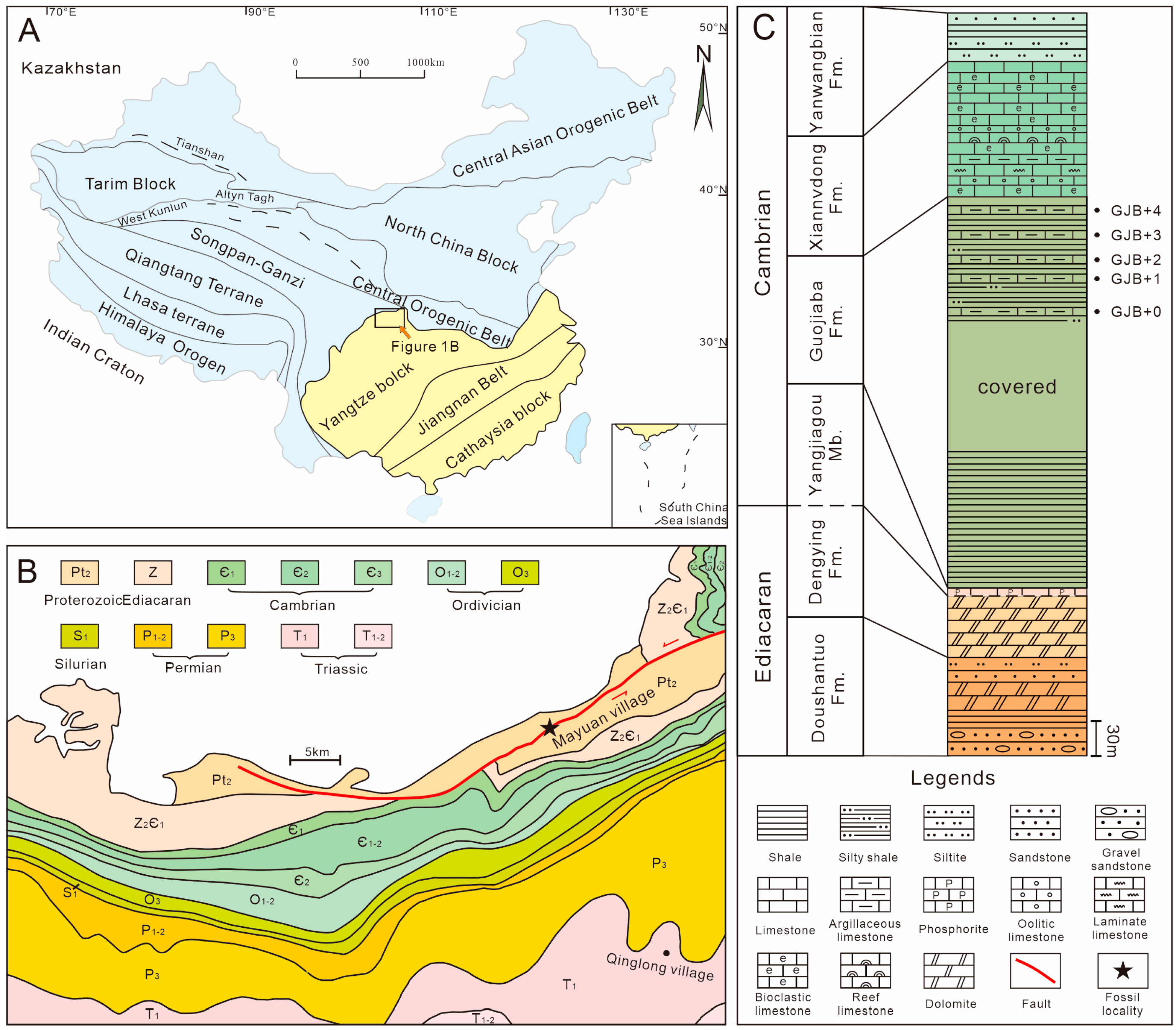
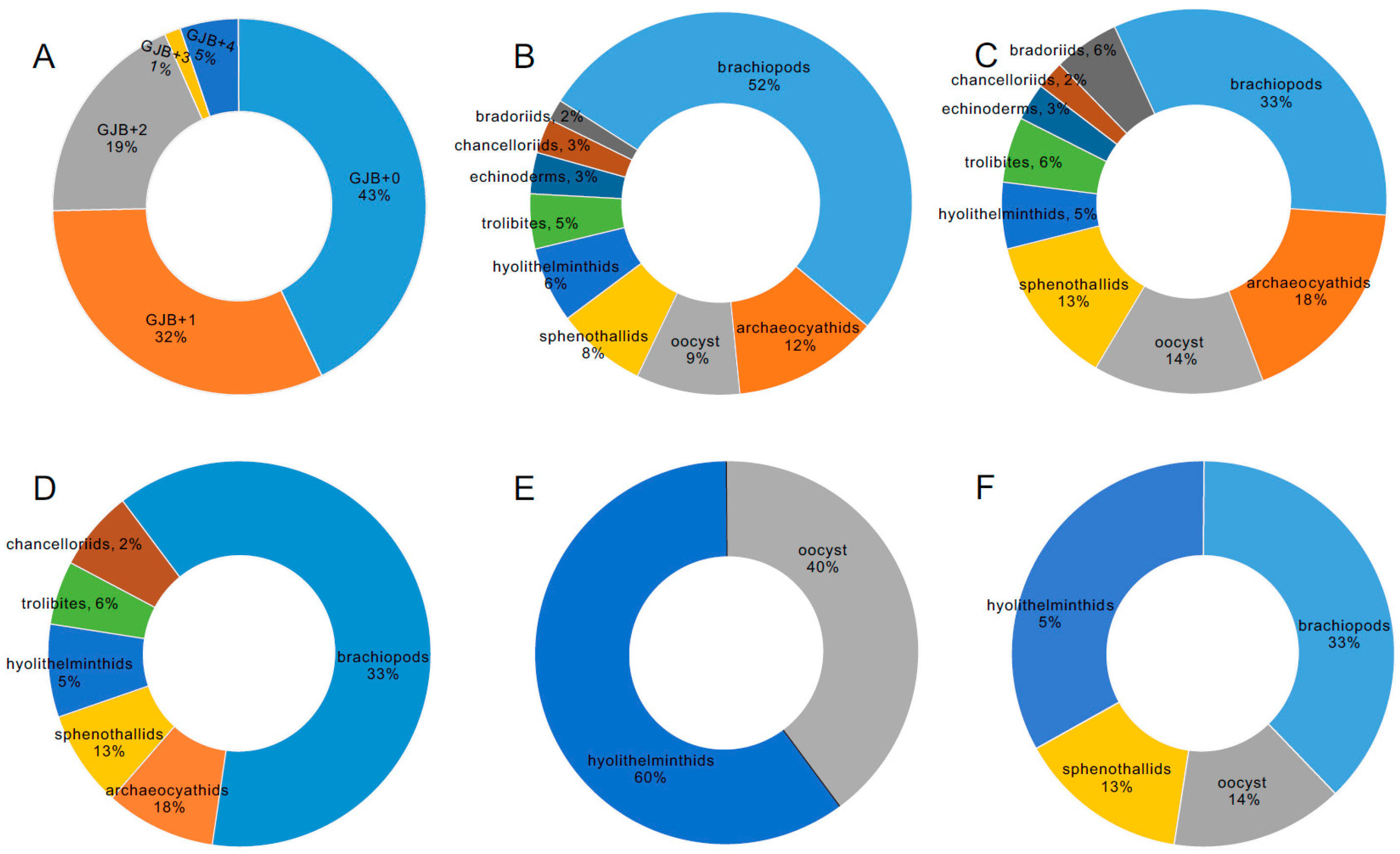
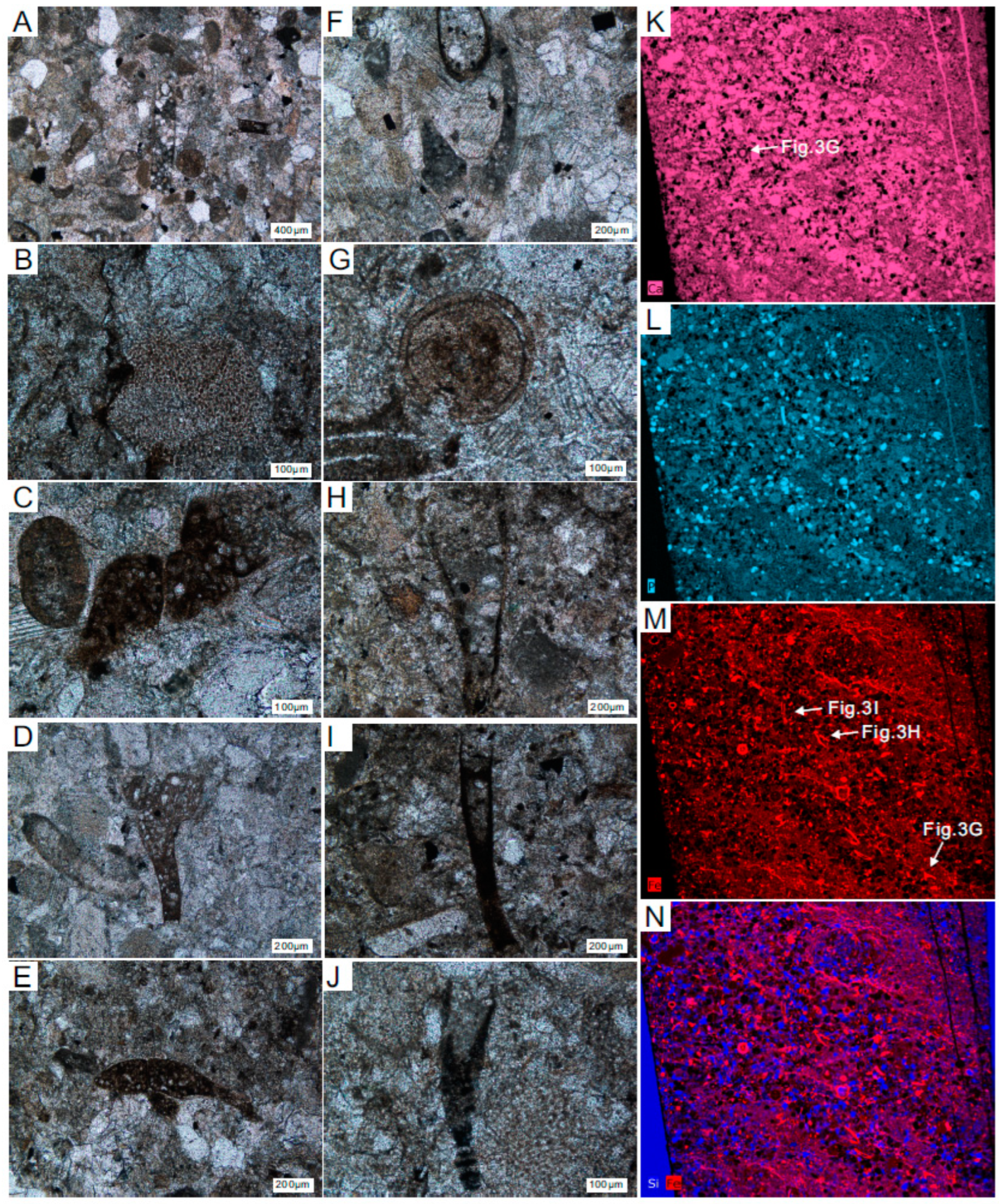
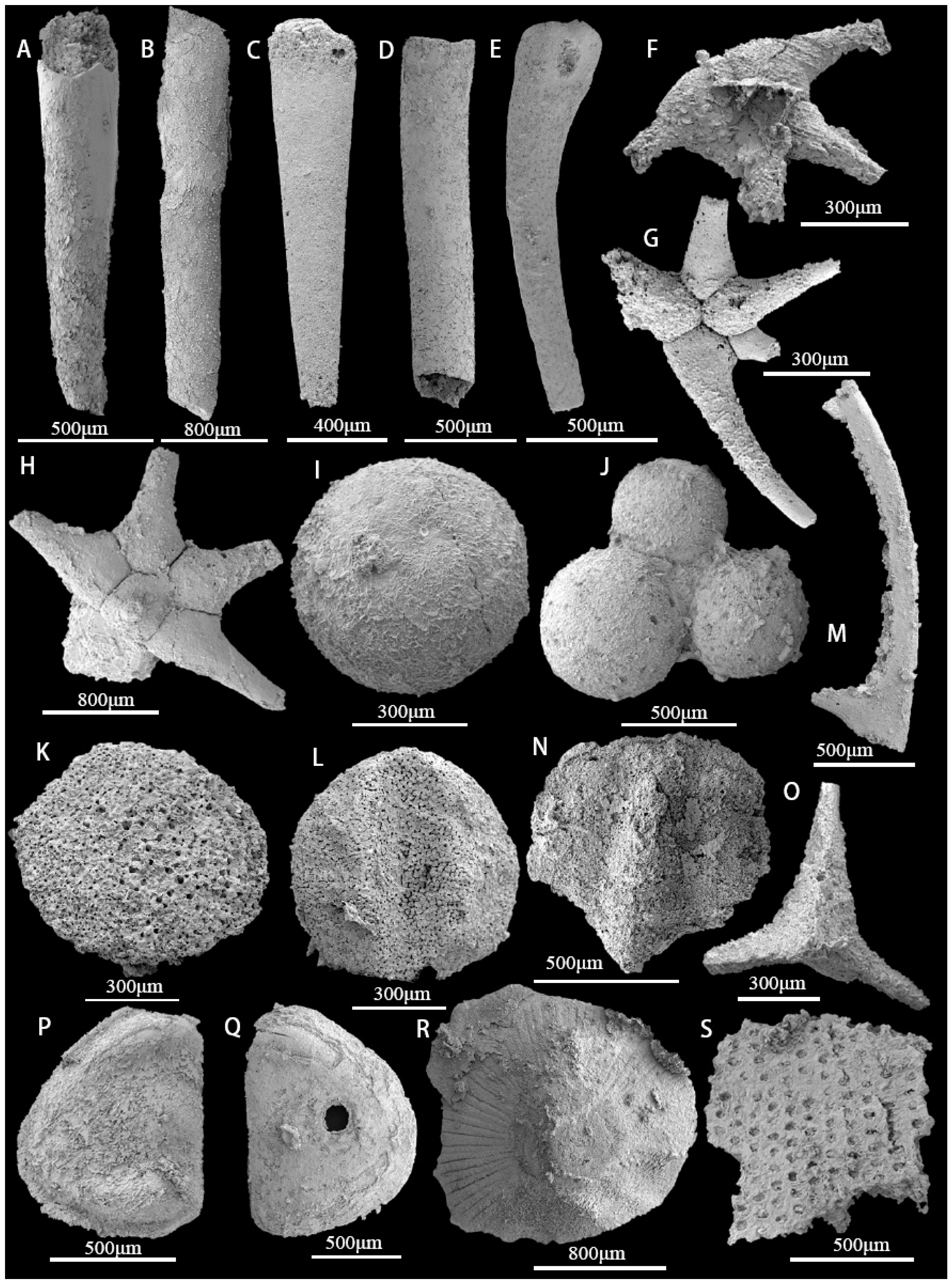
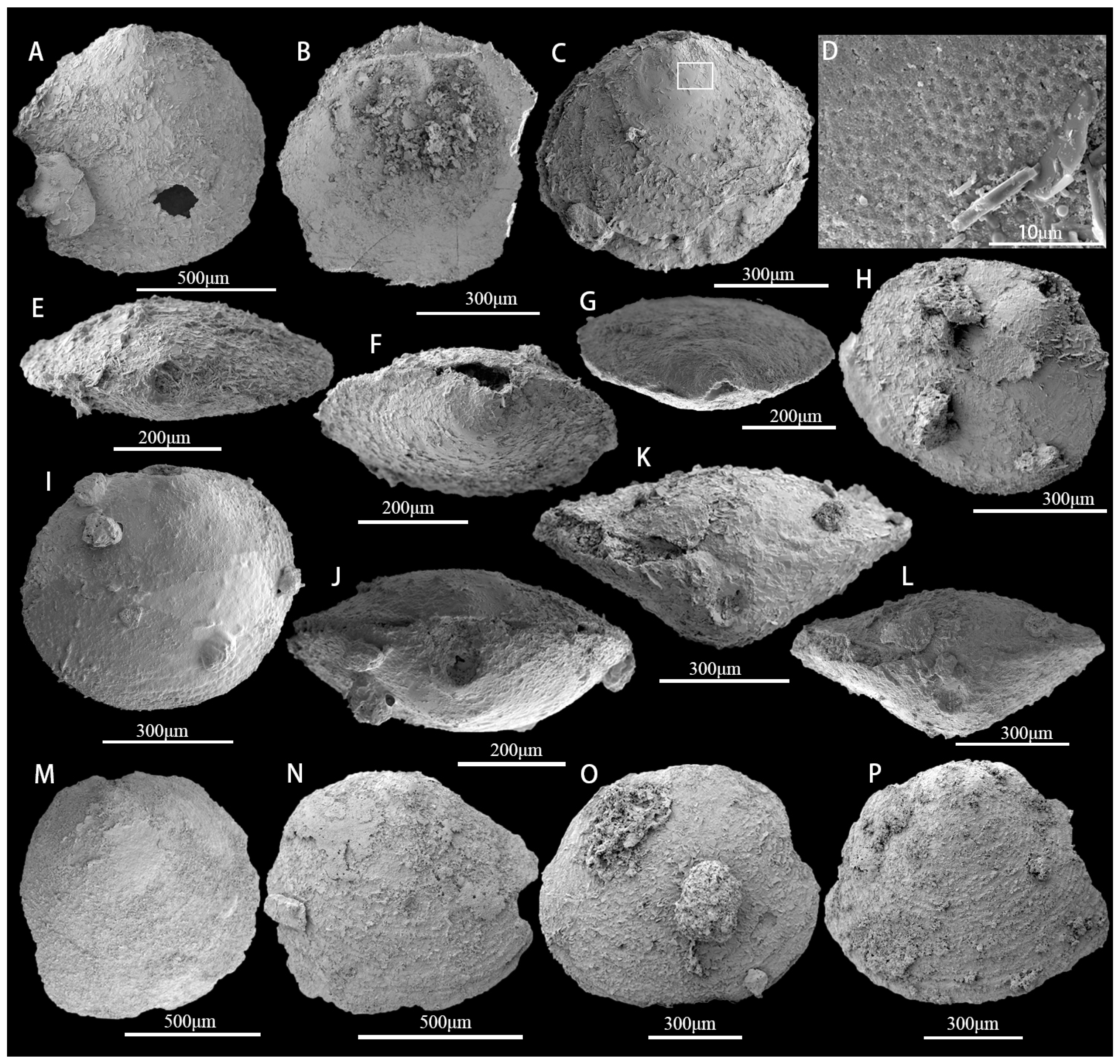
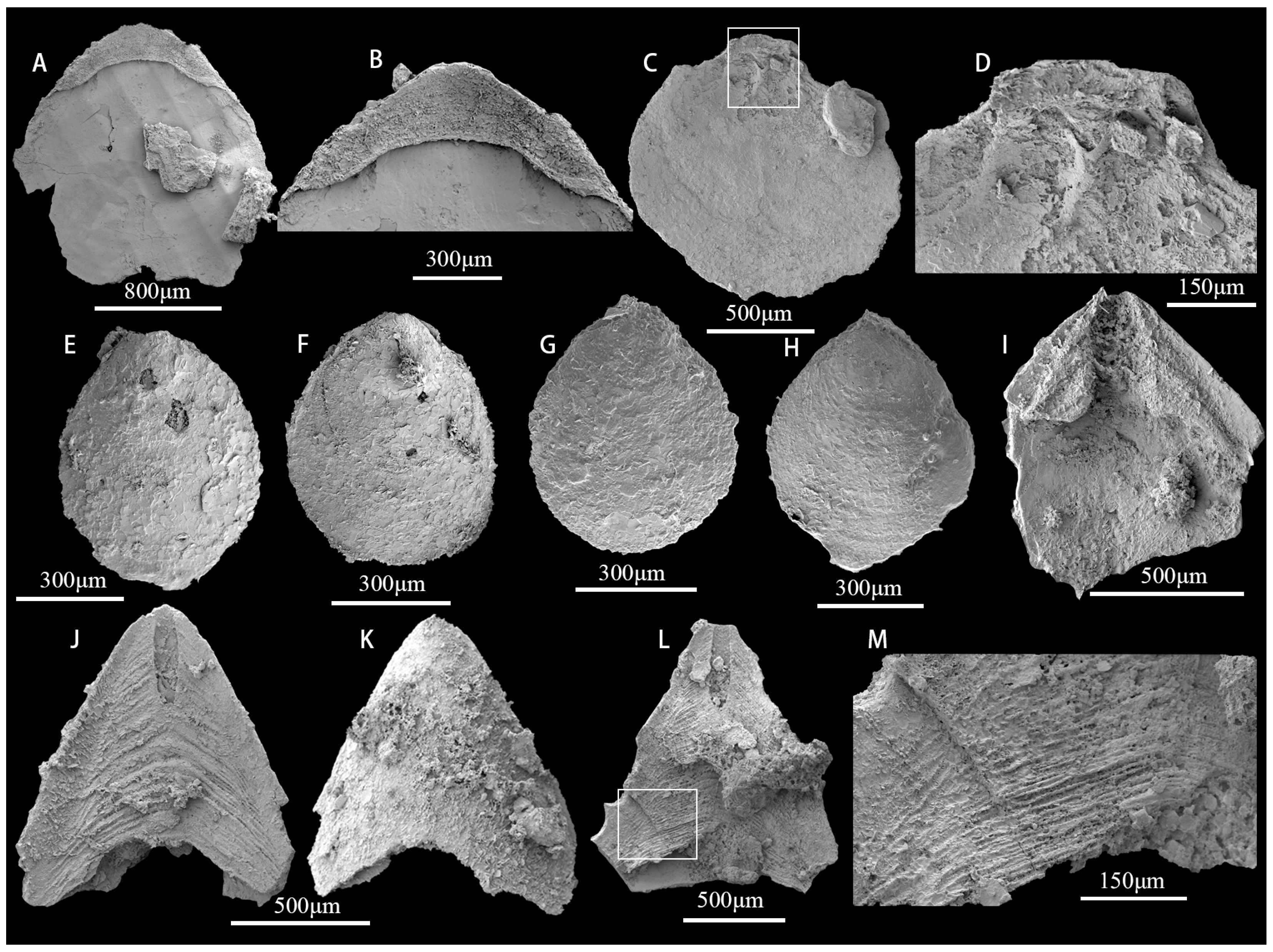
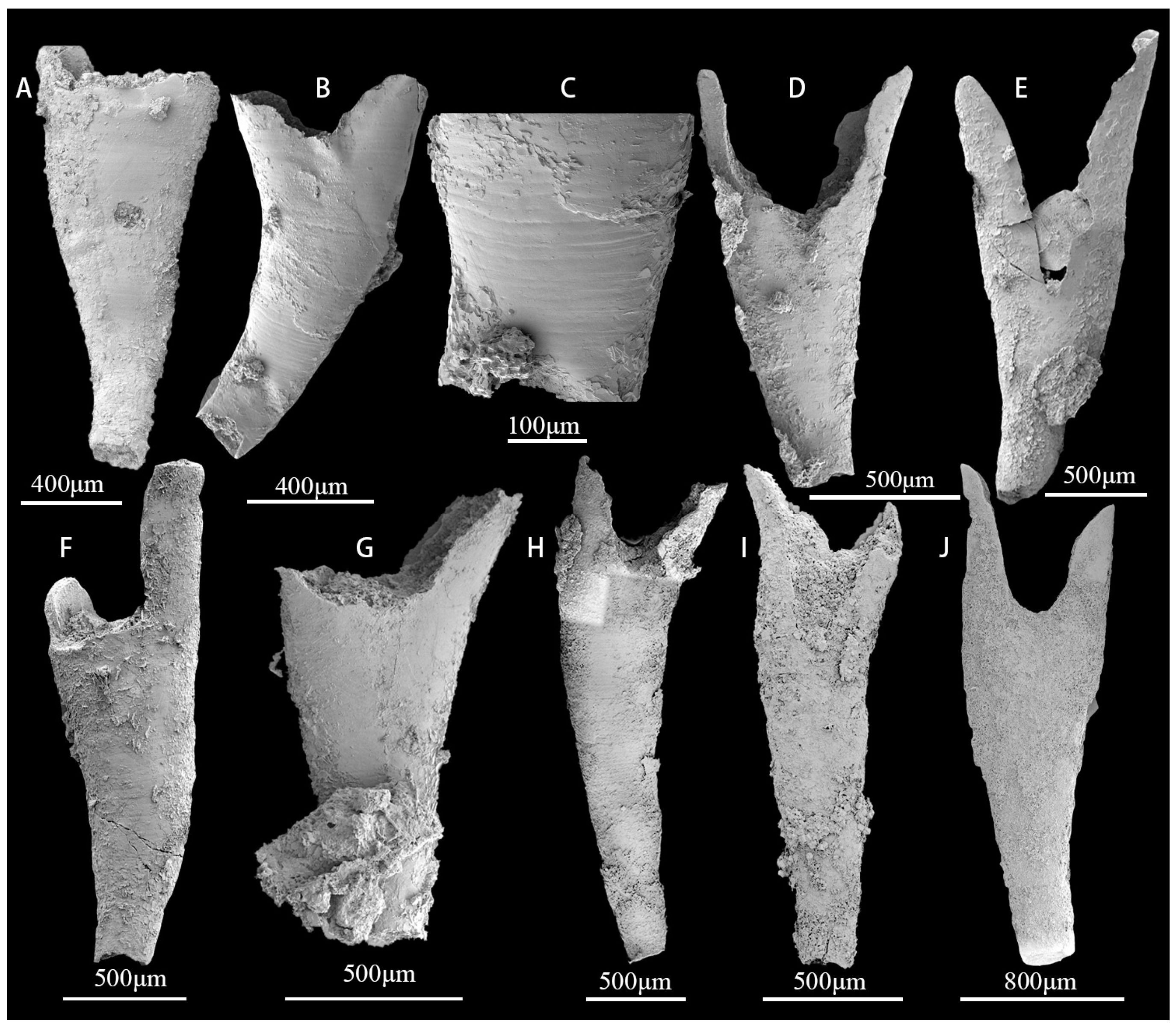
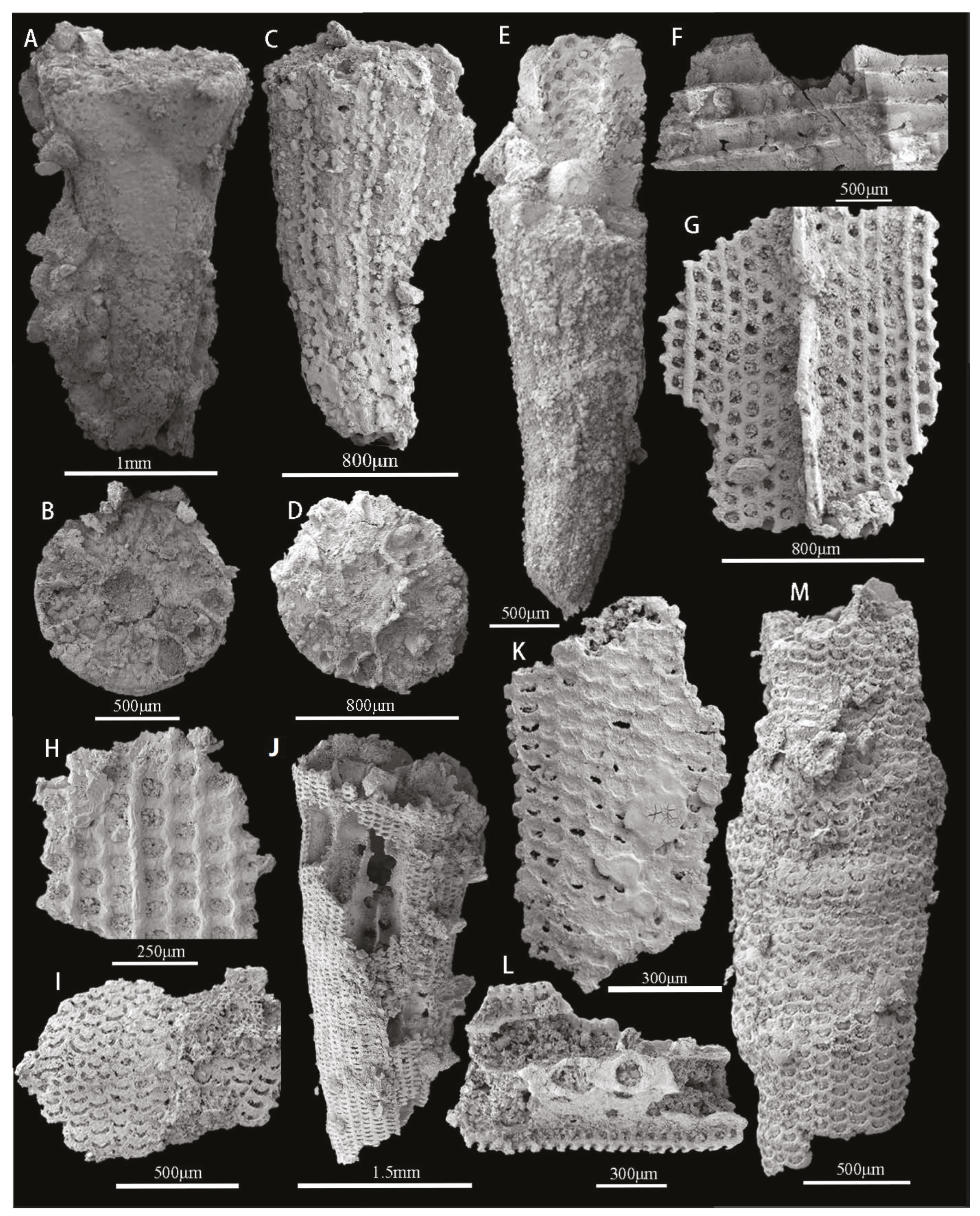

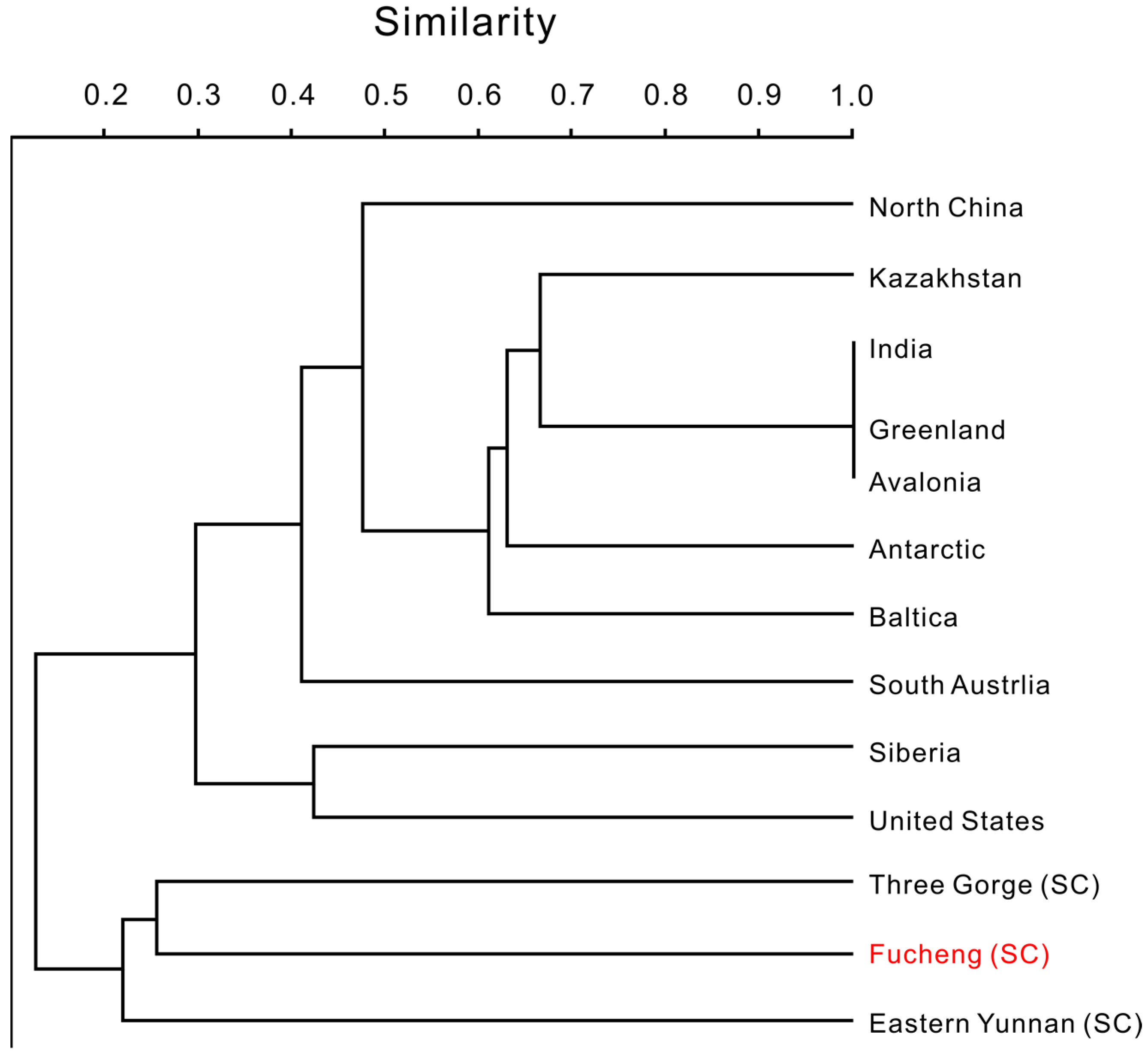
| V | L | W | Lms | Wms | Lf | Wf | L/W | Lms/L | Lf/L | Lf/Wf |
|---|---|---|---|---|---|---|---|---|---|---|
| Count | 13 | 18 | 17 | 17 | 14 | 15 | 12 | 12 | 8 | 14 |
| Min | 478 | 485 | 99 | 127 | 31 | 51 | 0.84 | 0.15 | 0.06 | 0.4 |
| Max | 907 | 925 | 195 | 223 | 76 | 99 | 1.09 | 0.30 | 0.14 | 1.06 |
| Mean | 632 | 625 | 138 | 177 | 60 | 82 | 0.95 | 0.22 | 0.09 | 0.4 |
| SD | 110 | 125 | 32 | 32 | 12 | 15 | 0.08 | 0.04 | 0.026 | 0.15 |
| V | L | W | H | Lms | Wms | Lf | Wf | L/W | Lms/L | Lf/L |
| Count | 8 | 8 | 5 | 5 | 4 | 4 | 8 | 8 | 4 | 4 |
| Min | 544 | 580 | 262 | 174 | 192 | 59 | 57 | 0.81 | 0.29 | 0.07 |
| Max | 1034 | 1265 | 394 | 204 | 226 | 91 | 84 | 1.12 | 0.30 | 0.14 |
| Mean | 734 | 760 | 328 | 182 | 208 | 79 | 74 | 0.97 | 0.30 | 0.11 |
| SD | 177 | 227 | 62 | 17 | 13 | 9 | 10 | 0.11 | 0.003 | 0.022 |
| D | L | W | Lms | Wms | Lp | Wp | Lc | Wc | L/W | Lms/L |
| Count | 12 | 12 | 11 | 11 | 2 | 2 | 2 | 2 | 12 | 11 |
| Min | 648 | 608 | 180 | 216 | 305 | 76 | 228 | 323 | 0.74 | 0.22 |
| Max | 1360 | 1316 | 426 | 419 | 383 | 114 | 434 | 430 | 1.24 | 0.43 |
| Mean | 893 | 889 | 294 | 343 | 344 | 95 | 331 | 376 | 1.01 | 0.32 |
| SD | 225 | 227 | 81 | 77 | 55 | 27 | 145 | 75 | 0.12 | 0.06 |
| V | L | W | Lms | Wms | Lf | Wf | L/W | Lms/L | Lf/L |
|---|---|---|---|---|---|---|---|---|---|
| Count | 5 | 5 | 5 | 5 | 2 | 2 | 5 | 5 | 2 |
| Min | 588 | 627 | 180 | 213 | 31 | 39 | 0.87 | 0.23 | 0.05 |
| Max | 988 | 947 | 236 | 260 | 65 | 47 | 1.04 | 0.30 | 0.06 |
| Mean | 771 | 824 | 209 | 236 | 48 | 43 | 0.93 | 0.27 | 0.05 |
| SD | 143 | 119 | 23 | 20 | 23 | 5 | 0.06 | 0.03 | 0.01 |
| V | L | W | Il | Iw | Pgl | Pgw | Aa | L/W | Il/Iw | Il/L | Pgl/L |
|---|---|---|---|---|---|---|---|---|---|---|---|
| Count | 5 | 5 | 5 | 5 | 5 | 5 | 5 | 5 | 5 | 5 | 5 |
| Min | 1378 | 986 | 820 | 884 | 350 | 88 | 52 | 1.25 | 0.84 | 0.53 | 0.23 |
| Max | 1623 | 1199 | 880 | 1039 | 485 | 103 | 57 | 1.5 | 0.92 | 0.59 | 0.29 |
| Mean | 1503 | 1088 | 850 | 959 | 394 | 95 | 55 | 1.38 | 0.88 | 0.56 | 0.26 |
| SD | 94 | 86 | 24 | 61 | 54 | 5 | 2 | 0.08 | 0.03 | 0.02 | 0.02 |
Disclaimer/Publisher’s Note: The statements, opinions and data contained in all publications are solely those of the individual author(s) and contributor(s) and not of MDPI and/or the editor(s). MDPI and/or the editor(s) disclaim responsibility for any injury to people or property resulting from any ideas, methods, instructions or products referred to in the content. |
© 2023 by the authors. Licensee MDPI, Basel, Switzerland. This article is an open access article distributed under the terms and conditions of the Creative Commons Attribution (CC BY) license (https://creativecommons.org/licenses/by/4.0/).
Share and Cite
Luo, M.; Liu, F.; Liang, Y.; Strotz, L.C.; Wang, J.; Hu, Y.; Song, B.; Holmer, L.E.; Zhang, Z. First Report of Small Skeletal Fossils from the Upper Guojiaba Formation (Series 2, Cambrian), Southern Shaanxi, South China. Biology 2023, 12, 902. https://doi.org/10.3390/biology12070902
Luo M, Liu F, Liang Y, Strotz LC, Wang J, Hu Y, Song B, Holmer LE, Zhang Z. First Report of Small Skeletal Fossils from the Upper Guojiaba Formation (Series 2, Cambrian), Southern Shaanxi, South China. Biology. 2023; 12(7):902. https://doi.org/10.3390/biology12070902
Chicago/Turabian StyleLuo, Mei, Fan Liu, Yue Liang, Luke C. Strotz, Jiayue Wang, Yazhou Hu, Baopeng Song, Lars E. Holmer, and Zhifei Zhang. 2023. "First Report of Small Skeletal Fossils from the Upper Guojiaba Formation (Series 2, Cambrian), Southern Shaanxi, South China" Biology 12, no. 7: 902. https://doi.org/10.3390/biology12070902
APA StyleLuo, M., Liu, F., Liang, Y., Strotz, L. C., Wang, J., Hu, Y., Song, B., Holmer, L. E., & Zhang, Z. (2023). First Report of Small Skeletal Fossils from the Upper Guojiaba Formation (Series 2, Cambrian), Southern Shaanxi, South China. Biology, 12(7), 902. https://doi.org/10.3390/biology12070902








